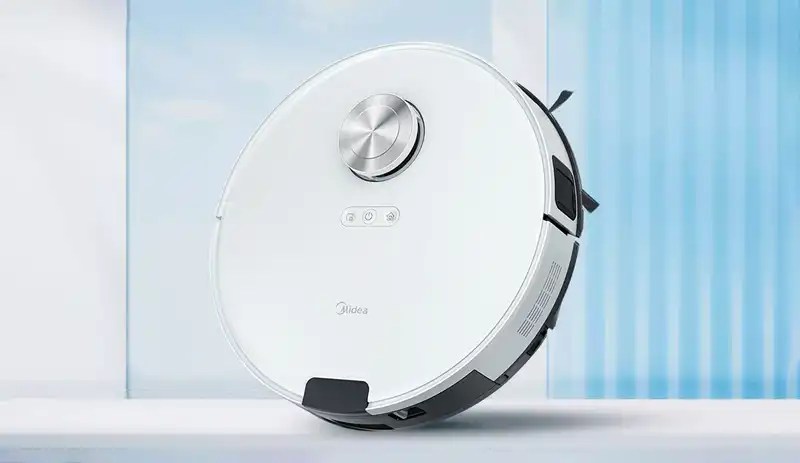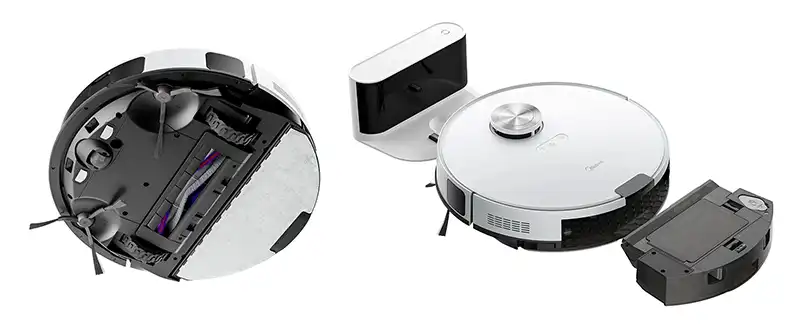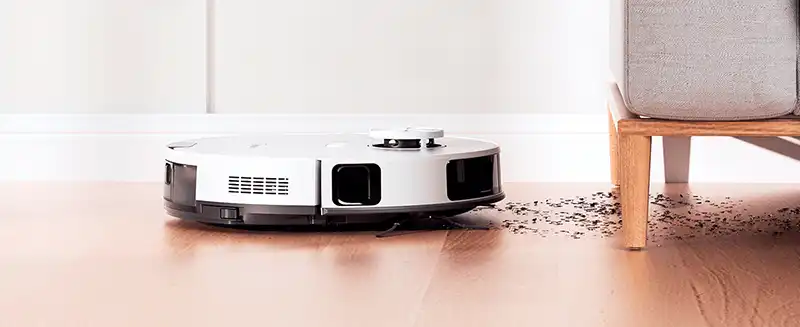You can also be interested in these:
If you are searching for an affordable but fully-featured robotic vacuum cleaner that can handle cleaning your house while you’re away, the Midea M9 may be a great option. This model boasts high-end features such as a mopping system, 4,000 Pa suction power, and a mop capable of applying pressure to the floor to enhance the results. Furthermore, it is priced lower than most comparable competitors. However, it remains to be seen if it can compete with high-end robots.
External characteristics
The Midea M9 robot has a standard circular design and is primarily constructed from rigid plastic. Its measurements are slightly larger than usual, with a diameter of 350 mm and a height of 97 mm including the navigation sensor. The weight is also slightly higher than average, at almost 5 kg, which increases when filled with water.

At the top of the robot, there is a cylindrical dome that houses the LiDAR navigation system, which has a silver roof and vertical supports to protect the rotating camera mechanism. In this case, there is no top cover because the deposit system is located at the rear and has direct access.
After the navigation sensor, we find the panel with three buttons that perform the following functions:
- Power button
- Network configuration/focused cleaning mode
- Recharge button
In addition to these functions, the main button has an integrated LED to indicate the status of the device, similar to the recharge and Wi-Fi buttons, which will blink when we enter configuration mode.
Moving to the lateral zone, specifically the front of the robot, we find the bumper that incorporates four object detection sensors and a spring-based movement system to absorb possible impacts in case of not detecting objects in certain situations. It has a small rubber edge at the bottom as protection against impacts, but this will not prevent protrusions at mid-height from scratching the shiny black plastic panel on top.

In the fixed rear half, we have the air exhaust grille on the right side and, very inconspicuously, a small hole to access the reset button, while there is also another grille on the other side.
Finally, at the rear, we find the deposit module with a quick extraction system using two buttons that activate the top lock. This module integrates the water, dust, and mop tanks, eliminating the need to flip the robot over to remove them.
Whisker brushes, deposit container and charging base
The underside of the Midea M9 has a two large rubber-gear wheels with individually motorized long-stroke shock absorbers that generate movement. At the front, there is a swivel wheel with a rubber tire for quieter movement that maintains the orientation and rotation of the robot.
On both sides of this wheel, there are two metal charging contacts that ensure that the robot makes proper contact with the base for charging. Four sensors around the front edge, coinciding with the bumper extension, detect changes in height to avoid falls. Additionally, there is an ultrasonic sensor next to the wheel that detects carpets and automatically lifts the mop module.
Moving on to the cleaning system, it consists of brushes for suction and a mop for mopping. On each side, there are rotating brushes that cover a wider area and reach corners. Additionally, they are bristle brushes which are, in our opinion, more effective than rubber brushes.
In the central zone, there is the main cleaning roller which has a 100% bristle design with a combination of stiffer and softer, thicker bristles to remove more dust than mixed brushes, as we confirmed. It has a movable system to adapt better to uneven floors, effectively removing dirt from rustic floor cracks, but some springs would increase the pressure on the floor.

The next component of the system is the deposit module, which is essentially 3-in-1. On the top, there is a button to access the dust bin, which has a small capacity of only 250 mL and fills up quickly. At least it has a visor at the entrance to prevent dirt from falling out. Above it, there is a filter module with removable HEPA filter and grille, which takes up too much space for our taste.
Bordering the module is the water tank with a rubber top lid, which has a capacity of 220 mL, higher than average and perhaps excessive as it takes up too much space compared to the dust bin. It would have been beneficial if it were transparent to see the water level and internal elements.
On the right edge, the water pump motor towards the mopping module is integrated, which will also be placed in the base with a velcro-attached mop around it. The mopping module is not fixed to the robot but to the base, so both can be removed independently. Additionally, the 10 mm travel pressure system that retracts or pushes the mop onto the floor will be integrated into the robot itself.
The charging base is quite simple but well-made, with a large parking area and a non-slip rubber base. At the rear, there is a system for winding and storing the remaining cable, as well as a charging indicator on the top.
Features of the Midea M9 vacuum robot
As we have mentioned from the beginning, the Midea M9 is a robot capable of vacuuming and mopping. This is a relevant aspect given its price, but another one is that its motor offers a maximum suction power of 4,000 Pa. The application offers four power modes: the typical three and a quieter night mode, although none specify the noise generated.
The water cleaning system consists of an electric motor that pumps water to the mop with multiple outlets to evenly moisten the entire area. It has four water flow modes, from dry to fully wet, with the latter recommended for deeper cleaning.
To achieve efficiency in movement and adaptability, the Midea M9 has a navigation system based on a LiDAR sensor located in the upper dome with a precision of 10 mm and a range of 8 m. This is supplemented by four SLAM laser sensors located on the bumper with the ability to detect objects with a precision of 9 mm. The package is completed with a carpet detector and tilt sensors. Together, they form a very efficient system from the first step with map recognition, and even better once the map and optimal cleaning routes are created.

The robot’s connectivity is based on Bluetooth for unit detection and 2.4 GHz Wi-Fi for management from the app. The battery is also at a high-end level with a capacity of 5,200 mAh, offering a maximum runtime of 180 minutes in quiet suction mode. Charging is as slow as in any other robot, taking about 7 hours for a full cycle, as we have confirmed.
Management app, setup and use
The Midea app will be available in the Google app store, so we can install it and create a user account to start using it.
The first step is to add the device, which we can do automatically or manually. In our case, we did it manually by searching for the model in the list of devices since it was not detected automatically. Once detected, the app will ask us for the password for the Wi-Fi network we choose, and the process will be carried out automatically to the end.
Upon entering the device’s functions, we are presented with several menus located around the central area where the map and cleaning route are displayed. The first step is to create the map of the floor plan, allowing for a total of 3 maps to be stored. The important section is the cleaning options, where we have the water flow for the mop, suction power, mop lift switch, and carpet detection mode.
Moving on, we can manage our maps in the next section, allowing for the creation of custom partitions, assigning names, setting restricted zones, and virtual walls – a full range of features found in high-end robots.
In the general options section, we highlight the ability to configure Spanish language for voice events. We can also program cleaning schedules, enable a “do not disturb” mode, locate the robot, check information on consumables, access the manual or firmware updates.
Use experience
The Midea M9 offers impressive suction performance thanks to its unique central brush roller with two types of bristles – some stiffer and some softer – to capture even the smallest dust particles. The robot’s dustbin is capable of collecting more fine dust than most competitors, making it ideal for deep cleaning.
The delicate suction mode offers great suction power, while the maximum suction mode is incredibly effective but also noisy. The only downside of the central brush roller is that it can easily get tangled with long hairs, and it may struggle with wet spots on floors. However, this is a common issue with most robots.
It is difficult to estimate the battery life of the Midea M9 robot since it doesn’t display the numerical percentage, but after running for 50 minutes on the delicate mode, only one battery bar was used, which exceeds the specified runtime of over 2.5 hours.
While the Midea M9’s mopping system may seem similar to other robots that simply drag the cloth on the floor, it improves slightly with its movable system that applies pressure to the floor, resulting in a more even wetting of the cloth and, with some luck, the removal of more stubborn dirt.
Despite the effective cleaning performance of the Midea M9’s mopping system, it still struggles with cleaning dirt trapped in uneven surfaces like tiles. Additionally, the short bristles of the mop tend to miss the dirt on the edges of the floor. However, the water dispensing system is quite effective, but it is recommended to wet the mop before using it to ensure complete absorption.
The automatic retraction feature works well with carpets, but the 10 mm range is insufficient for cleaning long pile carpets without getting them wet. It is also advisable to remove small carpets to avoid entanglement with the brush roll, a common issue with many robotic vacuums.
Wrapping up our Midea M9 vacuum robot review
We conclude this review by providing our final thoughts on the Midea M9, a robot that we have generally liked, especially in the navigation and suction departments.
The navigation system is a complete marvel, with very few collisions, only if there are difficult-to-detect protrusions, optimizing the route very well after scanning the floor, and also being able to manage maps and detecting objects correctly. In this case, we can say that it is at a high-end level.
The installation system for the dustbin and mop is user-friendly and intuitive. However, the small size of the dustbin can be an issue for large homes with pets. The app for controlling the robot is good, but the lack of a recharge and resume cleaning mode is a downside.
The vacuum system is powerful, and the double-bristle roller is effective in capturing more dust. However, it tends to get entangled with long hair and retains more moisture. The mop system performs well, with good contact pressure against the floor. However, it lacks vibration or rotation, and the bristles are too short.
